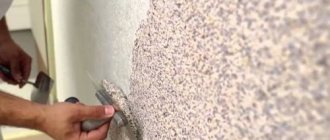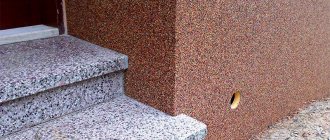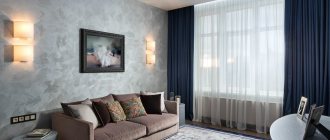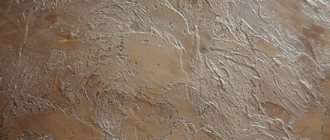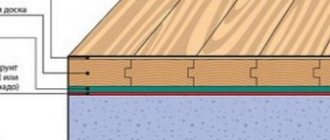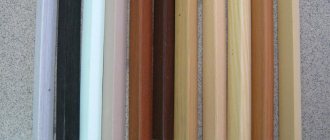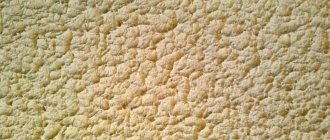In his treatise on architecture, Vitruvius gives a recipe and technology for applying a decorative coating, which is neither in appearance nor in strength different from natural marble, and does not crack. To do this, six layers of plaster mortar were applied - three sandy and three with marble filler. Marble plaster, which will be discussed below, differs from Vitruvian technology, components, and appearance. One thing remains constant – the presence of marble for wall decoration.
What is this
Finishing of the surfaces of the interiors of buildings and facades is carried out using various materials. Plaster finishing with marble is a durable, pleasant-looking coating that reliably protects the building structures it is applied to. To create it, a mortar is used, which, after hardening, can last up to 20 years, can be washed with a brush, and will not become moldy from dampness. It will delight you with the beauty of natural stone and the tones inherent in nature. The decorative coating is endowed with such qualities by the flour or small grains of marble present in its composition. According to the classification, marble plaster belongs to the mineral type of finishes.
Base finishing
Marble plaster for the plinth can be used for finishing purposes. The application process does not differ from the standard finishing work. You should first prepare the base, repair all the unevenness, cover it with a layer of primer, and wait until the walls are completely dry. After this, manual or mechanical distribution of the mixture is performed using special equipment.
Why do you need to finish the base?
Base marble plaster is necessary primarily to protect the base from excessive exposure to moisture. Since the basement floor is located below the planning level of the building, it is susceptible to moisture.
A durable coating will protect the walls from condensation, mold and various fungal colonies.
Types and composition of plaster mortar with marble
Marble processing waste is used as a filler for the plaster mortar: flour (Venetian or Venetian plaster) or calibrated chips (in some cases with the addition of grains of granite or another type of stone). The coating, often referred to in general terms as decorative marble plaster, is of two types, depending on the composition of the stone inclusions:
- Marble, in which only marble chips are used as fillers,
- Mosaic, in which the filler, in addition to marble, is granite (granite-marble or simply granite plaster for interior/exterior use), malachite, quartz, lapis lazuli, as well as other stones.
Fine-grained stone filler can have a spherical (rounded) or angular (crushed stone) shape. So that the solution can be applied in an even layer of the same thickness, the stone grains are fractionated. Therefore, the finishing mixtures differ in size of stone grains:
- fine-grained – with granulate 0.2-1.0 mm,
- medium-grained – granules 1-3 mm,
- coarse-grained – marble plaster for external use with grains of 3-5 mm.
The texture of the surface depends on the grain size. The finer the filler, the smoother the surfaces are, and the finer, more detailed patterns can be created. Therefore, coarse-grained mixtures are used for exterior finishing work, while fine-grained mixtures containing flour are used for interior decoration.
In addition to the stone filler, the plaster mass contains binders that bind the stone particles to each other and to the plastered surface:
- slaked lime, used since ancient Roman times;
- mineral binders (cement);
- acrylic latex water-soluble emulsion increases adhesion to concrete surfaces (polymers of acrylic resin, which in its pure form, when hardened, turns into plexiglass, impart frost resistance and some elasticity, as a result of which microcracks do not appear, and the durability of the plaster coating increases).
Other components of the plaster mixture include:
- additives imparting water-repellent properties,
- substances with an antiseptic effect,
- preservatives,
- mineral and artificial coloring pigments
- components from which marble plaster in the interior acquires additional decorativeness, for example, mother-of-pearl, sparkles, etc.
Material features and advantages
Plastering brick walls
Marble plaster or another name – Venetian plaster – is a natural material for wall decoration.
Its appearance solved the problem of the high cost of natural stone. The composition of plaster and marble dust made the material much cheaper. Thousands of years ago it was invented by the Romans and to this day the “recipe” has not changed. It is based on marble chips and polymer. Such components create a smooth surface with the illusion of depth and texture. You will find a large selection of marble plaster at bayramix.su.
The material imitates marble, conveys its texture and fits perfectly on any surface. It is especially important to use plaster in areas where natural stone is too expensive and impractical. For example, for finishing columns or brackets. Marble plaster in the interior adds individuality to the room, playing with light, creating a magical atmosphere in the room.
Marble plaster coating:
- breathable;
- regulates indoor humidity;
- increases the wear resistance of surfaces;
- practical in the process of care;
- durable;
- durable and resistant to mechanical damage;
- insensitive to environmental influences and precipitation;
- environmentally friendly.
This surface enriches modern interiors and exteriors. It becomes an accent, elegantly emphasizing the overall style of the space.
DIY marble plaster mortar
Recipes for making decorative paste for decoration with your own hands:
Recipe 1:
- filler: 1.89 l. – marble chips/flour;
- binder: 1.89 l of sand-cement mixture or slaked lime;
- color: pigment of the desired color;
- plasticizer: 360 ml linseed oil + 30 ml soap;
- 180 ml water.
Recipe 2:
- filler 3 parts – crumbs and/or flour;
- binder 1 tsp – slaked lime (interior), white cement M400 and higher (for facades);
- water.
Obtaining a homogeneous mass with a drill with an attachment is not difficult.
Manufacturers of mixtures
Textured plaster compositions with marble chips are produced by domestic and foreign manufacturers. Their cost varies widely, but in general it is several times higher than that of conventional cement or gypsum.
The most famous brands:
- Ceresit (German brand HENKEL Bautechnik GmbH) - produces a wide range of affordable facade mixtures (“pebble”), which contain various fractions of other minerals along with marble chips. A distinctive feature of the brand is a 30-year warranty on finished finishing;
- VGT (Russia) – produces ready-made mixtures with a grain size of 1.0-1.5 mm for interior and exterior decoration, as well as auxiliary materials (primers, paints, varnishes, impregnations);
- Bolars (Russia) – the brand’s products are famous for their “Crystal” series, produced with three fractions of marble chips (0.5 mm, 1.5 mm and 2.0 mm). The ready-to-use mixture for external or internal use is packaged in buckets with a capacity of 15, 25 or 45 kg. The material has anti-vandal properties;
- San Marco (Italy) - produces the thinnest variety of ready-made mixtures with 0.4 mm marble chips. Using special paints of the same brand, you can reproduce the effect of a silver or golden patina on the polished surface of the plaster;
- Parade (Italy) - produces paste-like compositions, with the help of which it is possible to obtain a coating with the effect of natural polished marble with a slight touch of patina. The assortment includes mixtures that are varied in structure and decorative capabilities, with universal use and exceptional durability.
For convenience and speed of work, ready-made mixtures are usually used
The cost of the work of craftsmen specializing in Venetian plaster is highly valued - no less than the cost of the material itself. At the same time, you can master decorating skills yourself. Even the most experienced beginner can achieve an attractive result with the help of modern high-tech compounds.
Was this information useful to you? Share in the comments!
Advantages and disadvantages of finishing with marble
The qualities and properties of mixtures are determined by their components. The advantages/disadvantages of plaster compositions depend on the type and proportions of the composition.
The following positive qualities can be noted:
- durability,
- wear resistance,
- not susceptible to fungus, rot, mold,
- strength (the most durable with the addition of granite chips),
- resistance to precipitation (also used in damp rooms, for example in the bathroom),
- resistance to aggressive atmospheric substances,
- vapor permeability (condensation does not accumulate on the walls),
- withstands large temperature fluctuations,
- immunity to ultraviolet radiation (does not fade or deteriorate, no need to paint),
- non-toxic,
- easy application (which makes it suitable for finishing surfaces of various configurations - columns, figured ledges, niches, etc.),
- versatility (fits well and adheres to surfaces made of various materials: drywall, concrete, brick, etc.),
- practicality (easy to repair, clean),
- non-flammability,
- hiding power (helps hide surface unevenness),
- variety of ready-made mixtures,
Flaws:
- vulnerability to some acids,
- greater specific gravity of the coating due to the presence of stone components,
- plastering is carried out only at temperatures from +5 to +35°C,
- the possibility of plastering facades only after the building has settled,
- not one of the cheapest (applies more to ready-made formulations).
Pros, cons
The advantages of finishing include:
- Good strength, resistance to damage. This increases the useful life. Compositions containing granite chips are more durable.
- Wide selection of shades and their combinations.
- Good vapor permeability - condensation does not settle, so natural air exchange is not disturbed.
- Environmentally friendly. Marble is a natural material, does not poison the environment, and does not affect health.
- Resistance to sun, wind, precipitation. The color lasts for 13-16 years.
- Suitable for interior decoration, facade repair, regardless of the base.
- Easy to clean - when protection is applied, damage and contamination are not a problem for the finish for a long time.
- Easy dismantling.
- There is no risk of the appearance or spread of mold, mildew, or bacteria.
- Optimal price-quality ratio.
Advantages
Flaws:
- hardening too quickly - the solution must be used up in 40-45 minutes, then it deteriorates and becomes unusable;
- application technology - requires a lot of knowledge, skills in working with the material, and accuracy. In the absence of minimal experience, it is better to trust the masters;
- intolerance to chemicals - this especially applies to hydrochloric acid, so the use of aggressive cleaning agents is prohibited;
- high price.
Required Tools
To carry out plastering work you will need:
- an electric drill with a nozzle for stirring the solution or a drill mixer,
- masking tape,
- mixing container,
- stainless steel trowel,
- spatulas wide, narrow,
- metal graters,
- roller,
- Master OK,
- roulette,
- flat brush,
- ladder,
- building level,
- rags.
Do not forget to use covering material, it will make it easier for you to clean up after work.
Basic mistakes during preparation and application
The first mistake is non-compliance with technology. Before making a decorative finish, it is often necessary to first level the wall with rough plaster. After this, it is important to wait until it dries completely and then apply a special primer. If you start decorating too early, you end up with unsightly bubbles appearing after some time.
Puttying the walls before their subsequent finishing with Venetian plaster is done with a moisture-resistant composition. This is a mandatory condition, since any ready-made plaster mixture contains moisture. If for some reason you had to use a non-moisture resistant putty, this can be corrected by applying a special deep penetration primer with strengthening properties.
Other common mistakes:
- put the mixture on a spatula in small portions so that its distribution along the wall is smooth and uniform;
- the working surface of a spatula or trowel must be cleaned periodically, since dried fragments will leave untidy grooves on the surface;
- It is impossible to level a dried surface with a spatula; it will only leave deep scratches;
- defects in the design are corrected by applying a new portion of the mixture on top, since coarse sandpaper cannot be used.
Preparing the walls
Before applying marble plaster, the surface on which it is applied is properly prepared. A surface that has minor defects does not need to be leveled before applying the decorative solution with crumbs. An ideal surface is needed only for the Venetian. Existing pronounced irregularities are filled with putty or removed with a float.
The walls are dried and primed (for better adhesion). Metal parts must be cleaned of rust. If solutions with copper sulfate or drying oil were previously applied to the wall, it is coated with PF-115 enamel for neutralization. To achieve a better decorative effect, as well as to prevent stains from appearing, the surface is painted with a composition with a tone close to the color of the decorative coating (second primer). After applying each preparatory layer, it must be thoroughly dried.
Color range of marble mixture
Facing and finishing the facade with marble plaster allows you to achieve a natural pattern through the use of natural components. Most often, the coating has a natural color scheme, but the addition of additional mineral elements allows you to change the shade. Now in construction stores you can find a fairly wide range of colors.
Technology of applying mortar with marble chips
In order for the finishing solution to lie evenly and firmly, plastering is carried out at a temperature of +5 – +30°C. And if, for example, mosaic marble plaster is applied to a facade, it is better not to work under the scorching sun. Facades are also not plastered when it rains.
If ready-made mixtures are used (packed in plastic bags), then before use they are poured into a container for mixing, water is added to them in the amount indicated on the packaging (for packaging 15 kg - up to 1 liter). Mix thoroughly using an electric drill with an attachment. The main thing is that there is no free water left.
Since the mixtures lose moisture when drying and shrink (the layer becomes thinner), it is not recommended to take a break from applying one layer. In one day, without long breaks, it is necessary to cover the entire surface to be plastered, doing this from corner to corner in horizontal rows (row after row). Then the time interval between applying rows will be short. Otherwise, after drying, all the joints formed during the break will be clearly visible. If the area to be treated is so large that it cannot be dealt with in one working day, then its space is limited with masking tape.
Properties of marble coating, specific application
Plaster made from marble chips is chosen from a different palette; solutions are made from three main shades. One of them is considered the main one, and the other two - shading - are used to dilute the main color. For example, when composing a mixture for light marble, a beige tone is considered the base tone, and it can be supplemented with light brown and milk additives. If you purchase a ready-made solution in sealed packages, then you just need to carefully study the samples from the catalog. Factory solutions are distinguished by the finest grinding and come with additional primers.
The advantages of this traditional, but always relevant finish are:
- Nobility and style. Marble plaster will turn any surface into a work of art. It can be used in rooms for any purpose; it will be appropriate when creating interiors of different styles.
- Resistance to external influences of any kind: a special coating will protect the surface from moisture; consumers note the impact resistance of the composition and the absence of accidental chips.
- Resistance to the development of fungal cultures.
- Environmental friendliness - natural ingredients make the plaster harmless for all categories of consumers.
- The strength, reliability, and durability of the material surpasses many other finishing options.
Craftsmen note that marbled plaster has good elasticity, which makes it possible to work with the composition in different conditions, and is neutral to the effects of light - the shades do not change throughout its entire service life.
The disadvantages of such a finishing material are higher prices for the main component and complementary compounds, as well as difficulties with dismantling during repeated repairs. Many people are confused by the cold-to-the-touch surface of artificially created “marble.”
Coating
Applying marble plaster is a simple process. The plaster solution is applied to the trowel using a spatula in small portions. Then, with pressure, it is applied to the surface to be plastered in a thin layer (with a thickness of 1 to 2 sizes of stone particles). The trowel is first held at a slope of 15 degrees to the wall, decreasing the angle until the mortar is completely transferred from the trowel. The small part of the mixture remaining on the trowel is thrown back into the container, since the remainder is thinner. After several cycles (3-4) of applying the mixture to the wall, the trowel is cleaned of its residues with a damp rag so that drying lumps do not lift up the layer being laid.
Begin to apply a layer from the bottom edge of the wall to be coated (from corner to corner). After applying the layer, after a short (15-30 minutes) period of time, it is rubbed, adjusting and smoothing, for which a steel float moistened with water is used. After completion of application, the layer is dried for at least 24 hours.
To improve performance, finishing with stone chips in high-traffic areas, corridors, and façade plinths can be varnished. This decorative coating can be washed with a brush and detergents. The varnish is applied with a roller. The surface to be treated is allowed to dry for 24 hours.
Briefly, the technology is as follows:
- the base (wall, façade) is prepared, defects are corrected if necessary,
- a layer of base primer is applied,
- the primer is allowed to dry for 24 hours,
- if necessary, apply primer with a color similar to the color of the decorative coating,
- a layer of decorative mortar with stone granules is applied,
- after 15-30 minutes it is smoothed out and rubbed,
- dries 24 hours,
- a protective varnish or wax coating is applied with a roller,
- daily drying.
Interior use
There is a difference between marble plaster for interior and exterior. It lies in the size of the marble grains. Fine-grained chips ranging in size from 0.2 to 1 mm are used for decorative finishing inside, and medium-grained (1-3 mm) and coarse-grained (3-5 mm) are used for the exterior. Such information will play a role if you are planning to independently purchase material in a store on a nearby street or on the Internet.
A variety of color solutions allows you to realize any designer’s idea. The material can be used to decorate walls in any room: bedroom, hallway and even bathroom, since marble plaster is moisture resistant. It fits easily on surfaces made of different materials. Wood, brick or concrete, with proper preparation, will become an equally reliable base.
If you have decided that you will have marble plaster, what material consumption should be included in the repair estimate? The calculation is very simple. For absolutely smooth walls with an average layer thickness, you will need 100-200 g per square meter. It is also interesting that a layer of marble plaster will not only serve as a beautiful decoration, but will also solve the issue of sound insulation.
When working with marble plaster, the designer’s imagination is unlimited. In the interior, it can be used both for complete wall decoration and for creating accents on individual elements. The finishing of cornices and columns is popular. You can further emphasize the beauty of this material using directional light.
Original facade decoration
Due to its high mechanical resistance, marble facade plaster is used for finishing walls, arched structures and plinths. In addition to the decorative effect, the material will add strength to surfaces. It is resistant to mechanical stress and environmental influences, which is why it is so often used for finishing elements in public places: parks, terraces.
The relatively low cost and durability of marble plaster are undeniable advantages. “Wearing it out” is very difficult, but applying it is simple. Anyone can handle the finishing process. It is enough to carefully study the sequence of actions and strictly follow the instructions.
Application stages and features
The list of the most unpretentious finishing materials includes marble plaster; you can easily learn how to apply it in a few hours. The main thing to remember is that the surface is properly prepared. The effect of marble coating depends on how smooth and clean the wall is. Also, to achieve maximum smoothness, you should choose a high-density product and apply it in a thin layer.
Before you start work, prepare the necessary tools. You will need: a mixing drill, a spatula, a flat brush and a steel float.
- Before application, the surface should be cleaned of dirt. All uneven surfaces should be filled and sanded. Minor cracks can only remain if you use coarse plaster.
- To ensure reliable adhesion of marble plaster to the wall, apply a primer and wait several hours until it dries completely. Go over it again with a primer in the color of the plaster.
- Apply marble plaster to the surface using a spatula. For the interior, a tool measuring 30 cm is sufficient. For facades, a larger spatula is used.
- Gradually take the mixture and carefully stretch it along the wall. To do this, you need to make an effort and press the spatula well, ensuring reliable adhesion of the plaster to the surface. Try to distribute the plaster evenly and finish working the entire wall before it dries so that the joints are not visible.
- Wait half an hour and apply the next layer. The thickness of one layer can be from 2 to 4 mm.
- There can be up to 10 layers of marble plaster, depending on the effect you plan to achieve.
- Sand the last layer with fine-grained sandpaper.
- Marble plaster should dry for two days at a temperature not lower than +5⁰C.
There should be no difficulties with applying marble plaster. It fits easily on any surface, including unprepared ones. Largely due to this, marble plaster receives the best reviews, both from construction professionals and from those who like to do their own repairs. It combines the best qualities of modern finishing materials: aesthetics, wear resistance and accessibility
To avoid mistakes, pay attention to the manufacturer, trusted companies, and take into account customer reviews. Your experience of using this material will be successful and will bring pleasure in the process of further use.
Application to the façade
Outdoor conditions differ from indoor conditions due to a number of factors. Facades are exposed to large temperature changes, exposure to precipitation (including aggressive ones), and the sun. More likely to be impacted. Therefore, special facade plaster with marble chips is used for exterior finishing.
It is recommended to start plastering facades in dry, warm weather. The façade material to be coated must have a moisture content of no more than 5%. The technology for performing external work is similar to that described above. Is it possible to do everything as during interior work? No, because it has its own nuances.
- For exterior finishing, mainly coarse-grained mixtures are used. Their specific gravity is greater, therefore there is a special requirement for the quality of processing of facade walls and compliance with all conditions ensuring high adhesion.
- The mortar protruding from the joints is knocked down on the brickwork, and the masonry itself is plastered and dried.
- The primer is applied in at least 2-3 layers, allowing each layer to dry. To do this, use a deeply penetrating acrylic primer. Cover it with a brush or roller.
- Marble or mosaic facade plaster should be stored in such a volume that it is enough to finish at least one entire wall (from corner to corner).
- It is also necessary to have enough time to apply it. Therefore, if possible, it is better to work together. One person will apply the coating, the second will grout it.
The work can be done manually or mechanically. For mechanical application, a pneumatic crumb thrower is used. For spraying, the nozzle is placed half a meter from the wall and directed from top to bottom. After pouring the solution, rub it in without allowing it to set.
After drying the finish, it is rubbed clean with a steel float. Then a protective varnish coating is applied. The varnish is selected from those for external use.
Color
Until recently, the color range of the material was limited to the natural tones of marble. After application, the surface turned out to be heterogeneous, since marble extracted from different layers was used to make the mixtures. Modern manufacturing technology involves the use of various dyes. With their help, the color range of plasters was significantly expanded and a stable shade was obtained. In addition, the colors withstand exposure to ultraviolet waves well, so the plaster on facades and plinths retains its color for 15 years, and on interior surfaces for up to 25.
Decorative material is available in a wide range of colors
Application of decorative material indoors
In the premises, plaster is used for interior wall decoration. As a rule, it is a fine-grained mixture. The use of a coarse-grained mixture visually burdens the room, therefore, if it is used, it is only in limited small areas for emphasis. The same applies to interior wall decoration such as decorative bark beetle plaster. The decorative layer should be thin, so they tend to make its thickness no more than 1-1.5 times the size of marble chips. If the area of the wall being processed is large, then you can use a crumb blower.
Marble plaster for interior work has a composition slightly different from the composition intended for harsh atmospheric conditions (by the way, it can also be used inside a building). The main difference is in the connecting component. For facades, a composition with an acrylic binder is used. Compositions with any binder are well suited for covering the walls of a room.
There should not be excessive moisture in the cement-based or lime-based room, so it is better to carry out work when it is not raining outside. The wall should not be exposed to direct sunlight. All electrical appliances built into the wall must be turned off until the finish is completely dry. It is recommended to replace varnish with wax, since when it dries, it releases unsafe substances that take a long time to erode.
Compound
It is easy to guess that the filler is marble dust with crumbs formed during the processing of marble or other rocks.
The composition also includes other components for adhesion. For example, emulsions based on acrylic, polymer, lime, with coloring components, and other inclusions. Some of the components add a tint to the material, the rest helps the plaster harden faster and hold better.
The ingredients help protect the coating from the formation of mold, mildew - antiseptics, moisture protection products.
But the crumb will not stay on the base - a binder will be required. Resins on acrylic impart elasticity, strength, moisture resistance and other important qualities.
There are additives that prevent the formation of cracks when drying and repel dirt. Decorativeness and characteristics depend on the filler. The requirement is identical grain fractions. This will make the marble plaster smooth, monolithic, and the crumbs will be calibrated.
The sizes of the fractions correspond to the purpose of the material. Fine-grained mixtures are suitable for renovations inside buildings; large-grained mixtures are suitable for decorating facades.
Fractions in plaster
The base is usually also finished with coarse plaster. The larger the fraction, the stronger the foundation. The cost of the material, consumption, and layer thickness also depend on the diameter of the particles.
Creating a stone design
To make the design more attractive, decorative plaster marble chips, which vary in color, are used. There is nothing complicated in applying decorative elements with linear outlines. Masking tape is used to ensure that two compositions with different colors applied side by side do not mix with each other. You will also need a strip of the required length and a pencil for the job. If a drawing of more complex outlines is needed, use patterns.
First, the drawing is thought out. Then it is transferred to the wall surface using a strip and a pencil. The area that is filled with a plaster composition of the same color is taped around the perimeter with masking tape. Then the first composition is applied to the area. At the same time, you need to try not to accidentally “paint over” areas behind the tape. The tape is carefully removed after 15-20 minutes.
A day later, a tape of adhesive tape is also glued to the edge of the dried composition laid the day before. It will help to avoid contamination of the border area with a composition of a different color, which is applied in a neighboring area. The tape is also removed.
Wall decoration with marble plaster
To apply marble plaster on walls, you do not need to have any special skills. Now all types of this material are quite easy to work with.
Application of marble plaster
You won't need many tools:
- a small basin or bucket in which the mixture will be diluted;
- trowels and trowels for plaster;
- flat brush;
- drill and construction mixer;
- tape, ruler, stepladder, roller for applying primer and other additional materials, which sometimes you can do without.
On a note! Marble plaster should only be applied to a surface that is clean, free of dust and debris, and without visible defects! If there are cracks on the facade, they must be sealed with cement mortar so that the wall becomes smooth. Before applying the plaster mixture, the wall surface is primed (for example, before applying the Bayramix marble plaster to the wall, the manufacturer recommends applying the Astar primer), then you should wait until the primer dries - this is about 24 hours at a temperature not lower than +20 degrees.
Step 1. The finishing material is prepared. The plaster mixture is poured into a clean container, and a little water is added there - about 1 liter per 20 kg.
Dry mixture pours out
Water is added
Step 2. The mixture is thoroughly mixed with a construction mixer at low speed.
Mixing the plaster mixture
Construction mixer price
Construction mixer
Step 3. Plaster is applied to the prepared surface using a trowel and trowel. The plaster is applied to a trowel, and then a uniform layer 1.5-2 crumbs thick is laid on the wall surface. Application is carried out in small areas.
Application of marble plaster
The layer should be 1.5-2 crumbs thick
Step 4. The entire surface of the wall is decorated in the same way.
Plaster is applied to the entire surface
Step 5. After the material has been applied to the wall, it is slightly dried for 15-20 minutes, and then the surface is further smoothed with a metal trowel. The latter should be clean and damp.
Plaster coating after smoothing
Step 6. The surface is well dried during the day. The color of the plaster will appear as the surface dries.
The plaster will take about 24 hours to dry.
Advice! To protect the surface from external influences, a protective mixture can be applied to the dried plaster. The work is done using a roller.
By the way, plaster of different colors can be applied to one wall. Then, during the formation of the pattern, it is necessary to use masking tape, which will also help protect those surfaces where there is no place for plaster from getting the solution. The adhesive tape is glued along the pre-applied markings.
An example of applying plaster of different colors
After the layer of plaster has been applied, you should wait a few minutes (usually about 15) and carefully remove the strip of tape. If two colors of plaster are joined in this way, then the joint line is carefully smoothed with a damp and clean trowel. By the way, to apply plaster of a different color above the joint, you will again have to use a strip of tape. This time it is glued with its edge flush with the edge of the already applied plaster. In the usual way, a mixture of a different color is applied, slightly dried, and then the strip of tape is simply removed.
Removing tape
In this way, you can make various patterns and ornaments on the facade walls. These can be curved lines, squares and circles. In order to get the design, cut out the required shape of the pattern or seal the surface with tape, according to tradition. But if you plan to draw curved lines, then it is better to use patterns. It is worth remembering that the background plaster layer is applied first, and only after it the pattern layer.
Baryte plaster
Used to protect premises from X-ray radiation, a widely used modern alternative to expensive lead screens. Recommended for finishing X-ray rooms, physical laboratories and industrial facilities with hazardous radiation values. Read this article for more details.
Prices for hopper bucket for plaster
Hopper bucket for plaster
Video – Master class on applying marble plaster
Approximate consumption
The manufacturer provides consumption rates on the packaging. In practice, the consumption may be more or less. This, first of all, depends on the skill of the plasterer. Decorative plaster mixtures with rounded grains are more flexible and can be laid more economically. Fine-grained mixtures require less to cover 1 square meter than medium- and coarse-grained ones. An online calculator will help you more accurately calculate the consumption of decorative plaster.
Approximate consumption (limits for different manufacturers):
- mixtures with coarse-grained fractions – up to 8 kg/m2,
- with medium grain – 4-5 kg/m2,
- fine-grained mixtures – 2-3 kg/m2,
- with a grain size of 0.5-1 mm – 1-2.5 kg/m2.
Conclusion
Decorative plaster based on marble chips is a beautiful, environmentally friendly material with excellent performance and protective qualities, which is easy to make and apply with your own hands.
Additional façade painting using marble chips
After the applied material has dried, the surface is rubbed clean using a specially designed metal float. Next, to achieve maximum coating strength, a special varnish is applied in thin layers.
The structure of the mixture allows you to visually disguise small flaws.
In practice, it is easier to treat the façade of a building with the material described here than with conventional plaster. There is no need to ensure that everything “lays down” perfectly evenly. The structure of the mixture allows you to visually disguise small flaws.
Calculation of material quantity
To find out how much decorative marble plaster is needed, it is important to determine the working area. When purchasing a dry product, follow the manufacturer's instructions. It indicates how much area can be covered with the prepared marble mortar.
We will just say one thing: no need to buy mixtures back to back. It is important to leave 7-10% of the mixture in reserve of the total volume. The fact is that some of the material remains on the working tools. Part on the walls of containers.
Manual plastering
Applying marble plaster manually requires preliminary preparation of the mixture itself. Since the mixture is thick, it needs to be diluted. To do this, just add water or solvent. The manufacturer indicates the proportions: look for information on the outside of the package.
The algorithm of actions is as follows:
- The container opens.
- Dry plaster is mixed. We work with a mixer.
- If necessary, add a certain portion of water.
- Take a small amount of the prepared solution onto a trowel, which must be held at an angle of 600.
- The mixture is applied to the work surface in an even layer in one direction. A little force is applied.
- Then the applied mixture should dry. 20-30 minutes is enough for this.
- When the material begins to set, it is rubbed with a special tool - grout. We work with a grater made of stainless steel, pressing the tool against the work surface. Processing (grouting) is performed in a circular motion with equal pressure.
- Again, time is needed for the plaster to dry, now completely.
And only after this, you can work with acrylic varnish. Often, a water repellent is used instead.

